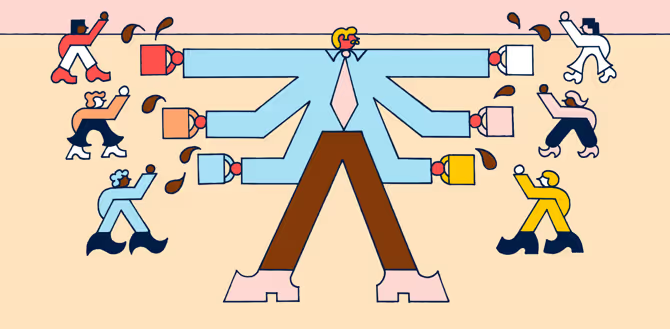How to manage creatives: 5 tips from an expert

Discover Workleap Officevibe's benchmark report on 12 key employee engagement metrics

Nick Patterson has been managing creative teams for over seven years as a co-founder of Storm & Shelter production house. With employees who work on film, animation, and video projects, he gets to coach and work with creative people every day. So, what’s uniquely rewarding about managing a team of creative employees? As Nick puts it,

From their passion and dedication to their innovative thinking, creative people tend to work together a little bit differently than more corporate teams. And this can be seen in everything from how they collaborate, to what kinds of collective goals they set, their work methods and project management style, and ultimately what they produce.
We spoke with Nick about the best and most challenging aspects of managing a team of creatives, and now we’re sharing all of his key insights with you!
{emphasize}
5 Tips from the interview:
- 1. Shift your perspective of development
- 2. Be mindful and intentional with feedback
- 3. Set goals that are led by creativity
- 4. Respect other people’s vulnerability
- 5. Prioritize openness and honesty
{emphasize}
What’s different about managing creative people?
If your team is working on projects that are design-oriented or innovative, then you might consider them to be a creative team. People who get into creative fields often have a real passion for their craft and identify strongly with what they do. Their skill sets might serve them beyond earning them a living, they could also be a key source of fulfillment in their lives.
For some creative workers, their job is deeply connected with their sense of self, and even of self-worth.
This is why it’s important to put extra care into how you manage creative employees. When you oversee a team of creatives, you’re supporting people who are doing what they love, and helping them achieve not just goals, but dreams. Managing creative people can be tough work, and feel really personal - and that’s also what makes it so rewarding.
5 tips to help you manage creative employees
All the stand-out tips from our interview with Nick Patterson on how to manage a creative team...
1. Shift your perspective of development
Creative employees need freedom when it comes to their growth and development. Try not to assume the next steps for your team members, and break out of seeing employee development as a linear path. When a creative person has the opportunity to move in different directions, they’re more empowered to find the right challenges for themselves.
Nick wants his employees to have "the confidence to say 'hey, maybe I could be stretched a little here.'" From there, it’s about "being able to give guidance and take time to give feedback, and giving people small responsibilities as they go to test things out." You want to give people the agency to direct their own career path, and help them figure out how their personal ambitions align with the goals of your team.
2. Be mindful and intentional with feedback
When it comes to giving feedback to a creative person, it’s important to be extra thoughtful about what you share, and how you share it. Taking into account people’s personalities and preferences is essential when you craft your feedback, Nick says. His advice?
Beyond delivering your feedback so it lands, you want the other person to understand why you’re sharing it and how it’s relevant to the bigger picture. Can your feedback help them achieve their goals? Will it help them grow? How might it improve their creative process? Be specific when you give context to it.
Check out our best employee feedback examples →
3. Set goals that are led by creativity
Rather than focusing on solely performance-based goals for employees, it might make more sense to set objectives that are driven by development. On setting individual goals with his team members, Nick says that "because the work is project-based it’s a bit more creative-led. It’s less of a case of people having solid KPIs. That part’s easy."
You can (and should) still track performance data and monitor the key objectives that are important for your team. But put extra time and effort into setting meaningful creative goals for people as well. How can they expand their expertise and become more skilled in their field? Prioritizing this doesn’t have to be separate from striving toward business objectives.
Check out our best employee goal setting examples →
4. Respect other people’s vulnerability
Creative employees often put a lot of passion into their work, and so sharing it with their team or manager can be nerve-wracking. This is why it’s important to be considerate when challenging an idea or giving negative feedback.
It can take a lot of courage to share creative work. And unlike other domains, there might not be a 'right' and 'wrong' way of doing creative tasks. If something isn’t making sense to you, ask questions to better understand it before you share a critique. Commit yourself to an open mindset and be curious to learn from your team.
5. Prioritize openness and honesty
This tip applies to every other tip on the list! Making honesty and openness a part of your core team values and creative workflow encourages:
- Seeing things from a new perspective,
- Giving candid feedback with care,
- Letting creativity lead the way, and
- Making space for vulnerability.
As Nick puts it: "One of the most important things, especially when dealing with a creative team, is openness and honesty. The more that people can be open and honest, the more they can trust each other."
That last part is perhaps most important: building trust. With a high-trust team, you’ll improve collaboration and increase productivity and innovation. People will feel empowered to do what they do best, and rely on one another for the right things. When they’re in it together, they’ll feel comfortable to take smart risks and try new approaches. And it starts with making space for honesty.
A final piece of advice
The last piece of advice Nick shared for managers of creative employees? "Don’t hesitate to give people responsibility." Give your creative team members the space to lead themselves, and you’ll be amazed at where they take you.
Give HR and managers the clarity, confidence, and connection to lead better every day.


%20(1).avif)


.avif)
.avif)








